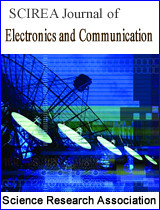SCIREA Journal of Electrics, Communication is an
international, scientific peer-reviewed open access journal
published online by SCIREA.
Open Access
free for readers, with article processing charges (APC)paid by authors or their
institutions.
High visibility: Indexed in the Google Scholar
and other databases.
Rapid publication:
manuscripts are peer-reviewed and a first decision provided to
authors approximately 20 days after submission; acceptance to
publication is undertaken in 5 days.
Recognition of reviewers:
reviewers who provide timely, thorough peer-review reports receive
vouchers entitling them to a discount on the APC of their next
publication in any SCIREA journal, in appreciation of the work
done.
Volume 2, Issue 1, February 2019
Open Access
N.Udaya Kumar, M.Madhavi Latha, E.V. Krishna Rao, K.Padma Vasavi
Abstract: An increase in the demand for storing the large archrivals’ of medical image data bases and the image data base for surveillance applications paved way for Region of Interest (ROI) based image compression techniques. Different ROI based coding techniques identify fixed shaped regions for compression. However, the real worl
Open Access
Bala Sindhuri Kandula, K.Padma Vasavi, I.Santi Prabha
Abstract: Carry Select Adder (CSLA) is the most popular choice for multiply and accumulate operations because of its high performance in fast computations. However, the major drawback for CSLA is resource utilization as it occupies more area and power when compared to Ripple Carry Adder (RCA). Low Power and area efficiency can be ach
Volume 1, Issue 2, December 2016
Open Access
Md. Yasin Javed Chowdhury, Md. Imrul Basher Chowdhury, Md. Iqbal Bahar Chowdhury
Abstract: The introduction of non-uniform doping profile in the quasi-neutral regions of a solar cell helps achieve better performance parameters such as higher conversion efficiency and improved current-voltage characteristics. However, a number of non-ideal effects becomes dominant as the doping level is increased; the transport pa
Open Access
Naser Ojaroudi Parchin
Abstract: In this study, a novel design of printed monopole antenna with band-notched function for ultra wide-band (UWB) applications is proposed .The antenna structure consists of a diamond-shaped radiating patch with stair-shaped slits and a ground plane with a pair of boomerang-shaped slots which provides a wide usable fractional
Open Access
Naser Ojaroudi Parchin
Abstract: In this paper, a new design of multi-resonance ultra-wideband (UWB) monopole antenna for microwave imaging systems is presented. The proposed antenna consist of a square radiating patch and a ground plane with pairs of rotated T-shaped strips protruded inside a pair of rectangular slots and an H-ring slot which provides a w
Open Access
Omer Aydogdu, Mehmet Latif Levent
Abstract: In this study, trajectory control of the Variable Loaded Servo (VLS) system is performed by using a Fuzzy Logic based Iterative Learning Control (ILC) method. In the study, a Iterative Learning PID (IL-PID) Controller is used as the iterative learning control structure. Also, a fuzzy adjustment mechanism has been added to t

